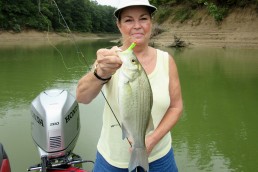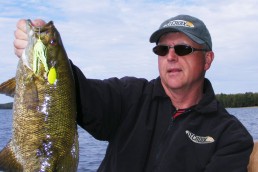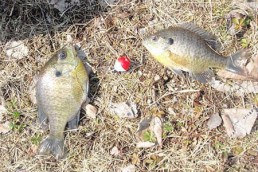Learning and Fishing New Bodies of Water
SHARE THIS POST
Learning New Lakes and Fishing New Bodies of Water
As a kayak nut, I like exploring new water around my home in southwest Michigan—and I am blessed to have lots of new places to fish around here. I find that fishing new bodies of water will help you to become a versatile angler.
A few years ago, I found our farm in the reliable Michigan Gazetteer map book, and drew a circle with a pencil, encompassing everything within 12 miles. Nineteen lakes with marked public accesses are within that circle. That didn’t include several other lakes with township-run public accesses not in the Gazetteer.
Since I participate in quite a few kayak bass tournaments, I almost always target bass first in any new water. Every trip is a practice session to discover new ways to work baits and—hopefully—to practice fighting fish to the net. I even practice taking their pictures on a Hog Trough bump board since it’s important to be efficient taking photos come tournament day. (Most kayak tournaments are Catch-Photo-Release format, with the winner decided by who has the most inches for five bass.)
I often know nothing about what kind of fishery these new lakes have, and that’s OK. If someone told me how great the bass fishing was in a certain lake, I’d be disappointed if I didn’t catch many. Life has sufficient disappointments without adding that one.
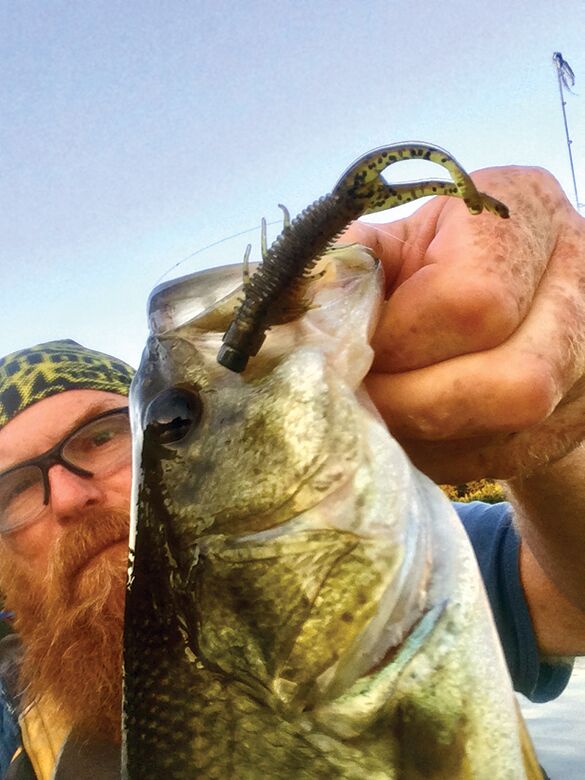
In my part of the Midwest, I can usually get a pretty good idea of what kind of fish are in a new lake by tossing finesse lures, which have become my favorite presentations. Tossing small lures like the 2 3/4-inch Z-Man TRD or other small plastic on a light jighead gets bites from almost anything that swims in any body of water. I’ve caught walleyes, bluegills, sunfish, crappies, big channel catfish, northern pike and even a muskie. Bass, too, both smallmouths and largemouths. Light jigheads range from a 1/32 Gopher Mushroom head, usually to nothing heavier than the Z-Man, 1/15-ounce ShroomZ head.
A lesson learned last year was to branch out with finesse offerings, and include swimbaits. I did quite well with a Keitech 4-inch swimbait (slightly shortened) and caught two of my biggest bass of the year the same morning in shallow water on a 3-inch MinnowZ in early June last year. Another good one has been the finesse-size Boar HogZ, which looks like some kind of insect larva. Bass eat that kind of thing, too.
The point is, a finesse presentation gets lots of bites. In May, many of the fish are up shallow, where the small jigheads and little lures really shine, and I can figure out whether or not the lake has a good number of bass.
So in my kayak, where taking too many rods is easy to do, I take five or six. Three are identical spinning combos, a 2500-size Shimano Sedona spinning reel on a 7-foot, medium-light action Shimano Convergence rod. These are all for finesse. I have a ton of confidence that this relatively inexpensive combo can land the fish that get hooked—I’ve had trouble landing them on lighter action, far more expensive rods.
These combos work great with no-stretch braided line—I like the light green, 10-pound test Slick8 Power Pro with a four-foot leader of 8- or 10-pound test Seaguar AbrazX Fluorocarbon. You can pretty much tell if your jig picks up just a tiny bit of algae, thanks to the sensitive line. The light green line is easy to see, should a fish grab your bait and swim toward you or off to the side. Plus, I think the smoother super line makes less sound when coming through the rod guides. Rougher-textured braids make sound that I think fish can detect. I’m all about being stealthy, and frequently turn off my sonar so the fish don’t hear its clicking.
Are you enjoying this post?
You can be among the first to get the latest info on where to go, what to use and how to use it!
The lures on two of these spinning rods are Finesse TRDs to start. One is a two-tone fishy pattern such as Mud Minnow, no matter the water clarity. The other TRD is in a more camouflage pattern such as Green Pumpkin if the water is clear, something with more sparkle like New Money or Mudbug if the water has some stain. I think this lure implies a small crayfish to bass. The third rod has a Keitech swimbait or MinnowZ in a subtle color that looks bluegill-ish, since ’gills are the main food for bass around here.
I try swimming these lures first, starting just slow and steady, rod tip perfectly still. If I get no takers, I reel slow while jiggling the rod tip to give the little lures more action. Especially with the TRD, this extra jiggle can make a big difference. I think it makes the short soft plastic transmit some subtle vibrations in the water and “feels” like something a bass is accustomed to eating, appealing to its lateral line. If that doesn’t work, I try a longer worm, like 3 to 3 1/2 inches of a 7-inch Finesse WormZ or a 4-inch Hula StickZ. I use the same light jigheads and fish the longer soft plastics at a variety of different speeds, too.
By the way, when tossing finesse lures from a kayak, an anchor is a hugely helpful accessory. You can work finesse lures much more effectively if wind isn’t blowing your little boat around.
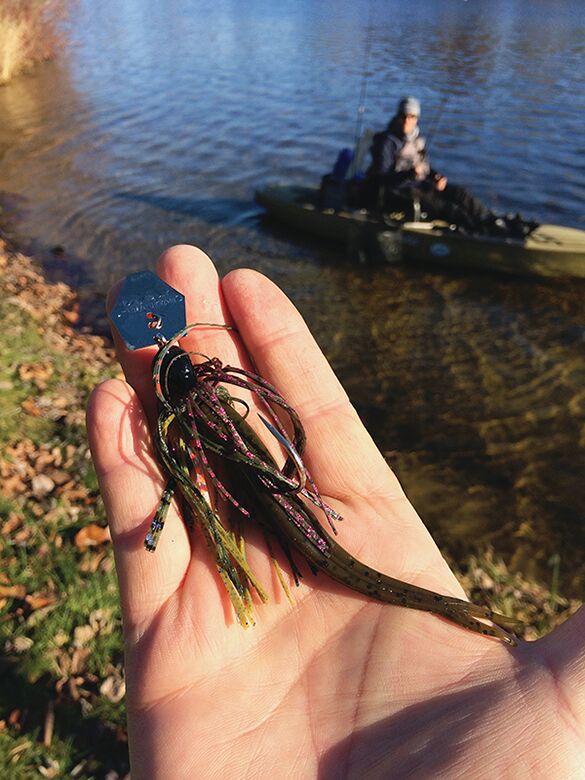
Eventually I switch to something more traditional for bass that I can throw on a baitcaster. Working a Ned Rig gets tedious and actually makes my right shoulder ache because of how I hold the spinning rod in my right hand and jiggle it sitting in my kayak. It’s a nice break to throw lures with a baitcaster in my left hand. A Texas-rig worm or a small jig on baitcasting gear with 15-pound fluorocarbon for the line are top choices for learning lakes. I’ve had great success with a Texas-rigged fluke-style bait, which looks more like a fish and has caught some nice bass when I creep it along the bottom like a worm or flip it into holes in the weeds. Fish frequently grab it as it sinks. A favorite is the Baby Bass pattern Strike King Caffeine Shad in the smaller, 4-inch size. I rig it on a 2/0 EWG Gamakatsu hook and peg a 1/16- or 1/8-ounce bullet weight to its nose, lately opting for the smaller tungsten weights. This is a go-anywhere lure that slides through weeds with ease.
On another baitcasting combo I like a small swim jig such as a 1/4- or 3/-16-ounce Strike King Bitsy Bug with a Zoom Swimmin’ Chunk. A swim jig is as versatile as lures get. You can swim it or even buzz it quickly through the tops of weeds. Or, you can fish it low and slow like a basic jig.
My sixth rod is dedicated to something I’m not real familiar with, just to try something new and hopefully get good with it. A couple years ago, the experimental rod was a swim jig. One year it was a weightless soft plastic jerkbait—a Zoom Fluke or a Lunker City Slug-Go. This year it will be one of the Z-Man ChatterBaits, mainly because some of my friends who beat me in tournaments regularly last season use them a lot. Makes sense. I’ve caught some fish on them over the past few years, but they usually were a last-ditch, let’s-see-if-this-works-since-nothing-else-did lure. This year I’ll experiment with different styles, weights and colors with different trailers. Everything I’ve read about them says they’re dynamite in weeds, which seems to be the most consistent bass pattern in most of the lakes I fish around here, especially in May and June.
Really, if you’re in a place with ample weeds (and on a lake without a lake association that thinks aquatic weeds need to be poisoned because they annoy wakeboarders), finding fish in May is pretty easy. Give the finesse stuff a try. Fish shallow and work your way out into the weeds. Chances are excellent you’ll encounter whatever swims in the lake, including some decent bass. MWO
Dave Mull, of Paw Paw, Mich., has spent his career communicating the outdoors experience and currently serves as the Digital Editor for MidWest Outdoors magazine and Television. He enjoys kayaking and fishing for anything that swims in the lakes and rivers of the Great Lakes states and beyond.
If you enjoyed this article, check out Dave Mull’s article on fishing the Ned rig.
MWO
SHARE THIS POST
Did you enjoy this post?
You can be among the first to get the latest info on where to go, what to use and how to use it!
Dan Brozowski
Passion for angling drives Dan Brozowski to the water’s edge virtually any chance he gets. Although passion cannot be measured, weighed, or recorded, it can be shared. He does this through his writing and while on the water. If you have any questions or comments for Dan, you may contact him at: onthebank@att.net.

